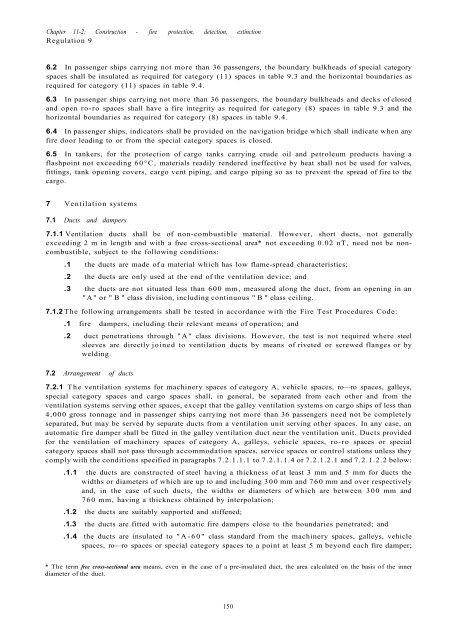Solas Consolidated Edition 2009.pdf
Solas Consolidated Edition 2009 for maritime
Solas Consolidated Edition 2009 for maritime
Create successful ePaper yourself
Turn your PDF publications into a flip-book with our unique Google optimized e-Paper software.
Chapter 11-2: Construction - fire protection, detection, extinction<br />
Regulation 9<br />
6.2 In passenger ships carrying not more than 36 passengers, the boundary bulkheads of special category<br />
spaces shall be insulated as required for category (11) spaces in table 9.3 and the horizontal boundaries as<br />
required for category (11) spaces in table 9.4.<br />
6.3 In passenger ships carrying not more than 36 passengers, the boundary bulkheads and decks of closed<br />
and open ro-ro spaces shall have a fire integrity as required for category (8) spaces in table 9.3 and the<br />
horizontal boundaries as required for category (8) spaces in table 9.4.<br />
6.4 In passenger ships, indicators shall be provided on the navigation bridge which shall indicate when any<br />
fire door leading to or from the special category spaces is closed.<br />
6.5 In tankers, for the protection of cargo tanks carrying crude oil and petroleum products having a<br />
flashpoint not exceeding 60°C, materials readily rendered ineffective by heat shall not be used for valves,<br />
fittings, tank opening covers, cargo vent piping, and cargo piping so as to prevent the spread of fire to the<br />
cargo.<br />
7 Ventilation systems<br />
7.1 Ducts and dampers<br />
7.1.1 Ventilation ducts shall be of non-combustible material. However, short ducts, not generally<br />
exceeding 2 m in length and with a free cross-sectional area* not exceeding 0.02 nT, need not be noncombustible,<br />
subject to the following conditions:<br />
.1 the ducts are made of a material which has low flame-spread characteristics;<br />
.2 the ducts are only used at the end of the ventilation device; and<br />
.3 the ducts are not situated less than 600 mm, measured along the duct, from an opening in an<br />
"A" or "B" class division, including continuous "B" class ceiling.<br />
7.1.2 The following arrangements shall be tested in accordance with the Fire Test Procedures Code:<br />
.1 fire dampers, including their relevant means of operation; and<br />
.2 duct penetrations through "A" class divisions. However, the test is not required where steel<br />
sleeves are directly joined to ventilation ducts by means of riveted or screwed flanges or by<br />
welding.<br />
7.2 Arrangement of ducts<br />
7.2.1 The ventilation systems for machinery spaces of category A, vehicle spaces, ro—ro spaces, galleys,<br />
special category spaces and cargo spaces shall, in general, be separated from each other and from the<br />
ventilation systems serving other spaces, except that the galley ventilation systems on cargo ships of less than<br />
4,000 gross tonnage and in passenger ships carrying not more than 36 passengers need not be completely<br />
separated, but may be served by separate ducts from a ventilation unit serving other spaces. In any case, an<br />
automatic fire damper shall be fitted in the galley ventilation duct near the ventilation unit. Ducts provided<br />
for the ventilation of machinery spaces of category A, galleys, vehicle spaces, ro-ro spaces or special<br />
category spaces shall not pass through accommodation spaces, service spaces or control stations unless they<br />
comply with the conditions specified in paragraphs 7.2.1.1.1 to 7.2.1.1.4 or 7.2.1.2.1 and 7.2.1.2.2 below:<br />
.1.1 the ducts are constructed of steel having a thickness of at least 3 mm and 5 mm for ducts the<br />
widths or diameters of which are up to and including 300 mm and 760 mm and over respectively<br />
and, in the case of such ducts, the widths or diameters of which are between 300 mm and<br />
760 mm, having a thickness obtained by interpolation;<br />
.1.2 the ducts are suitably supported and stiffened;<br />
.1.3 the ducts are fitted with automatic fire dampers close to the boundaries penetrated; and<br />
.1.4 the ducts are insulated to "A-60" class standard from the machinery spaces, galleys, vehicle<br />
spaces, ro—ro spaces or special category spaces to a point at least 5 m beyond each fire damper;<br />
* The term free cross-sectional area means, even in the case of a pre-insulated duct, the area calculated on the basis of the inner<br />
diameter of the duct.<br />
150


